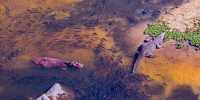Paleontology is the study of the history of life on Earth based on fossils. Fossils are the remains of plants, animals, fungi, bacteria, and unicellular living things that have been replaced by impressions of rock material or organisms preserved by the rock. It deals with all aspects of the biology of ancient life forms: their shape and structure, evolutionary patterns, geographical distribution with each other and with modern living species, and interrelationships with the environment. Paleontology is interrelated with stratigraphy and historical geology because fossils are a major way of identifying and relating sedimentary layers. As a result of Georges Quier’s work on comparative physiology, science was established in the 18th century and developed rapidly in the 19th century. The term is derived from the Greek palaces, “old, ancient”, “entity, animal” and the logo, “speech, though, the study”. Paleontologists have suggested that hydrangea, duck-bill dinosaurs lived in large herds. They made this hypothesis after observing evidence of social behavior, including a single site of about 10000 skeletons. Its investigative methods include biometry (statistical analysis in the field of biology) which is designed to statistically describe the forms of an organism and quantitatively reveal a hierarchical relationship.
Paleontology is a very broad subject and biologists do many different things with the same goal of understanding the history of life. Although the dinosaurs themselves lived 220 to 65 million years ago, humans are absolutely certain of their existence for less than 200 years. Ancient people speculated about the existence of creatures like dinosaurs. It now uses techniques taken from a wide range of sciences, including biochemistry, mathematics, and engineering. The use of all these techniques has enabled paleontologists to discover the evolutionary history of life in almost all ways when the Earth was able to support life about 3.6 billion years ago. Greek and Roman philosophers thought that fossils were remnants of ancient life forms preserved by the earth. The Chinese thought that fossil dinosaur bones were used for dragon bone and in purposes.
Paleontology has played a key role in reconstructing the history of the earth and has provided much evidence to support the theory of evolution. Dates of these remains are necessary but difficult to estimate: sometimes adjacent rock layers allow radiometric dating, providing accurate dates that are accurate to 0.5%, but often archaeologists rely on relative dating to solve biostratigraphic “jigsaw puzzles”. From old to rock layers). In 1815 the English geologist William Smith demonstrated the value of using fossils for level studies. Around the same time, the French zoologist Georges Cuvier began a comparative study of the structure of living creatures, including fossil remains. The last quarter of the twentieth century saw the development of molecular phylogenetics, which examines how closely related organisms are by measuring the similarity of DNA in the genome. Molecular phylogenetics was also used to estimate the dates when the species deviated, but this assumption depends on the fact that there is controversy about the reliability of the molecular clock.
















